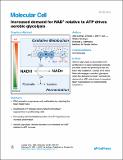Increased demand for NAD+ relative to ATP drives aerobic glycolysis
Author(s)
Luengo, Alba; Li, Zhaoqi; Gui, Dan Y; Sullivan, Lucas B; Zagorulya, Maria; Do, Brian T; Ferreira, Raphael; Naamati, Adi; Ali, Ahmed; Lewis, Caroline A; Thomas, Craig J; Spranger, Stefani; Matheson, Nicholas J; Vander Heiden, Matthew G; ... Show more Show less
DownloadPublished version (2.700Mb)
Publisher with Creative Commons License
Publisher with Creative Commons License
Creative Commons Attribution
Terms of use
Metadata
Show full item recordAbstract
Aerobic glycolysis, or preferential fermentation of glucose-derived pyruvate to lactate despite available oxygen, is associated with proliferation across many organisms and conditions. To better understand that association, we examined the metabolic consequence of activating the pyruvate dehydrogenase complex (PDH) to increase pyruvate oxidation at the expense of fermentation. We find that increasing PDH activity impairs cell proliferation by reducing the NAD /NADH ratio. This change in NAD /NADH is caused by increased mitochondrial membrane potential that impairs mitochondrial electron transport and NAD regeneration. Uncoupling respiration from ATP synthesis or increasing ATP hydrolysis restores NAD /NADH homeostasis and proliferation even when glucose oxidation is increased. These data suggest that when demand for NAD to support oxidation reactions exceeds the rate of ATP turnover in cells, NAD regeneration by mitochondrial respiration becomes constrained, promoting fermentation, despite available oxygen. This argues that cells engage in aerobic glycolysis when the demand for NAD is in excess of the demand for ATP. + + + + + + +
Date issued
2021Department
Koch Institute for Integrative Cancer Research at MIT; Massachusetts Institute of Technology. Department of Biology; Whitehead Institute for Biomedical ResearchJournal
Molecular Cell
Publisher
Elsevier BV